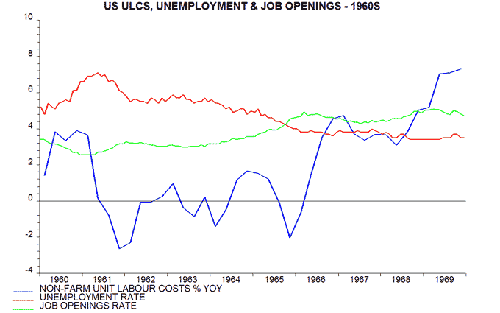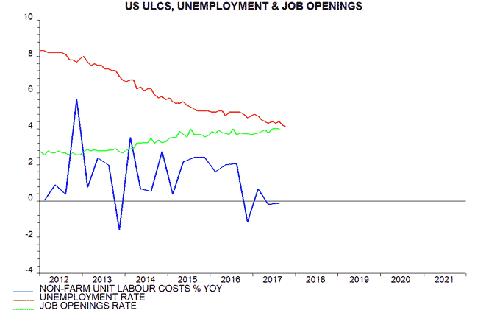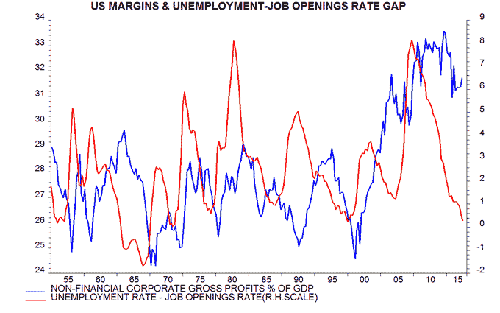
Janus Henderson: US worker shortage suggesting margin squeeze
US unemployment of 6.52 million in October has almost converged with the number of job openings (vacancies) in the economy, of 6.09 million in September. If the unemployed had the right skills and / or were in the right location, almost all would be in jobs. This is a reasonable definition of “full employment”.
13.11.2017 | 14:05 Uhr
The unemployment rate of 4.1% (4.07% before rounding) compares with a job openings rate of 4.0% (3.98%)*. The gap between the unemployment and job openings rates has fallen below 0.5 percentage points (pp) on only four occasions since the early 1950s – 1955, 1965, 1972 and 1999**. All four instances were followed by a rise in unit labour cost growth. Between the month when the gap fell below 0.5 pp and four quarters later, annual growth of non-farm unit labour costs rose by 6.7 pp, 3.6 pp, 5.0 pp and 2.7 pp respectively.
In 1955, 1972 and 1999, the unemployment rate converged with the job openings rate but did not fall below it. The economy subsequently weakened, the gap rewidened and the rise in unit labour growth was reversed.
In 1965, by contrast, the unemployment rate fell well beneath the job openings rate and a negative gap was sustained through 1970. Annual unit labour cost growth moved up from around zero in 1964-65 to 4% over 1966-68, with a further ratchet higher to 7% in 1969 – see first chart.

Developments since 2012 echo the first half of the 1960s, with annual unit labour cost growth remaining weak despite a steady narrowing of the unemployment rate-job openings rate gap – second chart. The gap fell below 0.5 pp in April 2017, suggesting – based on the historical experience – a rise in unit labour cost growth by mid-2018.

Faster unit labour cost growth would put upward pressure on (core) inflation and downward pressure on profit margins. Either would be negative for markets but the balance would affect the relative attraction of equities and Treasuries. A scenario in which margins took more of the strain, for example, would imply deteriorating economic prospects and rising recession risk, suggesting support for Treasuries despite a near-term inflation increase. Margins have fallen back since 2014 but remain elevated by historical standards – third chart.

* Unemployment rate = unemployment as percentage of employment plus unemployment. Job openings rate = job openings as percentage of employment plus job openings.
** Job openings data from December 2000 from Bureau of Labor Statistics; earlier data based on composite (i.e. print plus online) help-wanted series estimated by San Francisco Fed economist Regis Barnichon.



Diesen Beitrag teilen: